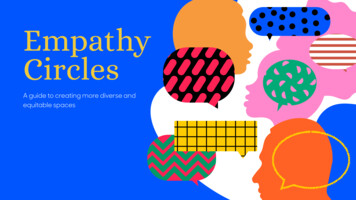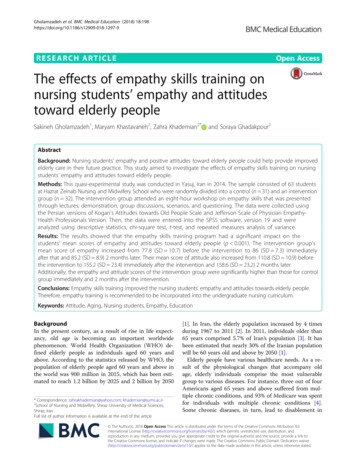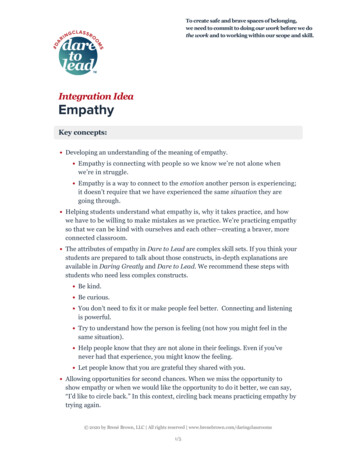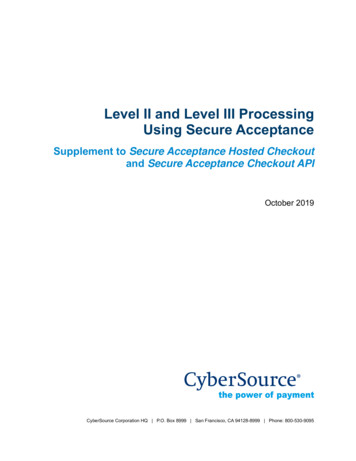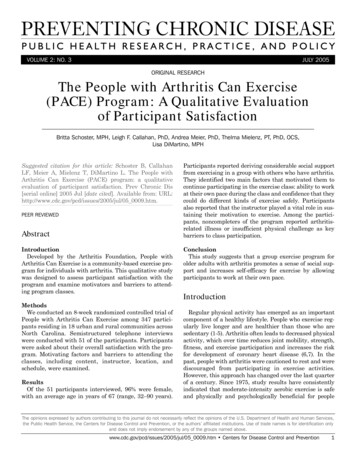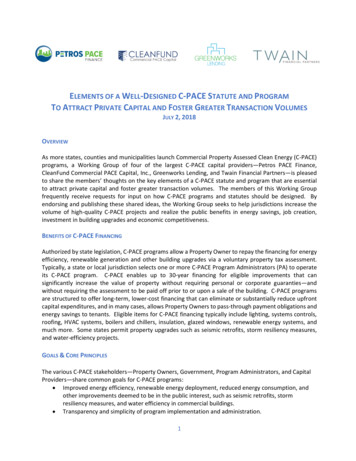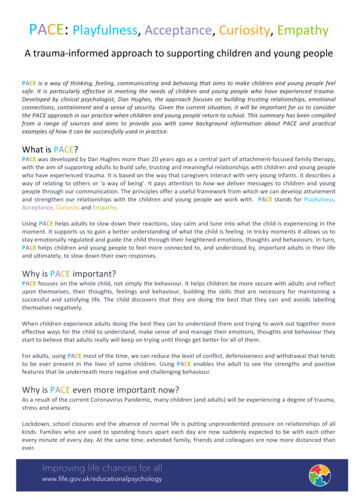
Transcription
PACE: Playfulness, Acceptance, Curiosity, EmpathyA trauma-informed approach to supporting children and young peoplePACE is a way of thinking, feeling, communicating and behaving that aims to make children and young people feelsafe. It is particularly effective in meeting the needs of children and young people who have experienced trauma.Developed by clinical psychologist, Dan Hughes, the approach focuses on building trusting relationships, emotionalconnections, containment and a sense of security. Given the current situation, it will be important for us to considerthe PACE approach in our practice when children and young people return to school. This summary has been compiledfrom a range of sources and aims to provide you with some background information about PACE and practicalexamples of how it can be successfully used in practice.What is PACE?PACE was developed by Dan Hughes more than 20 years ago as a central part of attachment-focused family therapy,with the aim of supporting adults to build safe, trusting and meaningful relationships with children and young peoplewho have experienced trauma. It is based on the way that caregivers interact with very young infants. It describes away of relating to others or ‘a way of being’. It pays attention to how we deliver messages to children and youngpeople through our communication. The principles offer a useful framework from which we can develop attunementand strengthen our relationships with the children and young people we work with. PACE stands for Playfulness,Acceptance, Curiosity and Empathy.Using PACE helps adults to slow down their reactions, stay calm and tune into what the child is experiencing in themoment. It supports us to gain a better understanding of what the child is feeling. In tricky moments it allows us tostay emotionally regulated and guide the child through their heightened emotions, thoughts and behaviours. In turn,PACE helps children and young people to feel more connected to, and understood by, important adults in their lifeand ultimately, to slow down their own responses.Why is PACE important?PACE focuses on the whole child, not simply the behaviour. It helps children be more secure with adults and reflectupon themselves, their thoughts, feelings and behaviour, building the skills that are necessary for maintaining asuccessful and satisfying life. The child discovers that they are doing the best that they can and avoids labellingthemselves negatively.When children experience adults doing the best they can to understand them and trying to work out together moreeffective ways for the child to understand, make sense of and manage their emotions, thoughts and behaviour theystart to believe that adults really will keep on trying until things get better for all of them.For adults, using PACE most of the time, we can reduce the level of conflict, defensiveness and withdrawal that tendsto be ever present in the lives of some children. Using PACE enables the adult to see the strengths and positivefeatures that lie underneath more negative and challenging behaviour.Why is PACE even more important now?As a result of the current Coronavirus Pandemic, many children (and adults) will be experiencing a degree of trauma,stress and anxiety.Lockdown, school closures and the absence of normal life is putting unprecedented pressure on relationships of allkinds. Families who are used to spending hours apart each day are now suddenly expected to be with each otherevery minute of every day. At the same time, extended family, friends and colleagues are now more distanced thanever.Improving life chances for allwww.fife.gov.uk/educationalpsychology
In addition to this, we are all experiencing our own additional stress and worries. This might include worries aboutkeeping ourselves and family members safe from the virus, financial stress, the trauma of losing a job or keeping abusiness afloat, trying to get to grips with homeschooling and meeting your kids needs and being disconnected fromloved ones. Some families will also be suffering the loss of a loved one to Coronavirus.Children are very sensitive to the reactions and moods of the adults around them. As well as experiencing their ownanxieties, children will be picking up on the stresses of the adults around them too. Although our children’s anxietiescan seem ‘small’ (e.g. missing their friends, changes to routine, not getting to play football), we must be careful notto minimise or dismiss these, but acknowledge them and give the child space to express their fears and sadness.With this in mind, it is important for us to think about how we can support children and their families on their returnto school. Our pupils will need supportive, understanding and PACE-ful adults to help them manage and understandtheir experiences and support the transition back to ‘normality’. It will be more important than ever for us to buildmeaningful connections and stronger relationships.PlayfulnessThis is about creating a fun, light and playful atmosphere when communicating with the child. It means using a lighttone of voice, like you might do when story-telling, rather than an irritated or lecturing tone. It is about having funand expressing a sense of joy.Relating with a playful attitude keeps the interaction light and upbeat. It can help diffuse a difficult or tense situation.Children are less likely to respond with anger and defensiveness when the adult has a touch of playfulness in theircommunication. Being playful could mean having fun with shared games or a shared activity that involves you both.Having a playful stance isn’t about being funny all the time or making jokes when a child is sad. It’s about helpingchildren be more open to and experience positive connection. While such a response may not be appropriate at thetime of risky or distressed behaviours, when applied to low level behaviours, playfulness can help keep it all inperspective.AcceptanceThis is about accepting that whatever the child (or you) are feeling right now is ok. You are accepting their thoughts,feelings and perceptions without judgement. You may not agree with their interpretation, but you accept theirfeelings about it. It is their experience and this is important. Don’t minimise or invalidate it. Show them it’s ok to feelthe way they do – actively communicate to the child that you accept their feelings and thoughts underneath theobservable behaviour.For example, a child may tell you “I know you hate me”. It is tempting to respond with “that’s not true” or “don’t saythat” but this may leave the child feeling that you really don’t understand what it’s like for them. Instead, throughusing PACE we could respond with “I’m sorry you think I hate you, that must feel awful, no wonder you’re angry withme” or “I didn’t realise that you feel like that, I’m sorry it feels that way to you”.Acceptance does not mean you have to accept the behaviour if this is harmful to themselves or to another person.You can limit the behaviour while at the same time understanding and accepting the motives for the behaviour.Convey your acceptance through your tone of voice - try using a ‘story-telling’ or gentle tone, showing your interest,showing your understanding and maintaining a non-judgemental stance. Acceptance is most clearly conveyedthrough non-verbal communication.CuriosityThis is about approaching children with an air of curiosity. Seek to understand what it is that drives them. What isimportant in their life? How can you get to the core of who they are and bring out the best in them? Curiosity meansyou don’t judge them so quickly. You can ask more questions of them, as you are curious to know more about them.Improving life chances for allwww.fife.gov.uk/educationalpsychology
Curiosity involves a quiet, accepting tone: “What do you think that was about?” or “I wonder what ?” You say thiswithout anticipating an answer or response from a child. This is different from asking the child, “Why did you dothat?” with the expectation of a reply. Children often know that their behavior was not appropriate. They often donot know why they did it or are reluctant to tell adults why.If an adult can stay curious about why their child is behaving as they are, the child and adult are less likely to feelcross or frustrated. With curiosity we are trying to show we simply wish to understand why. We hope to convey thatour intentions are to truly understand and help the child, not to lecture.EmpathyEmpathy is about putting yourself in someone else's shoes and allowing yourself to feel what they must be feeling. Itgives us a sense of compassion for the child and their feelings. This is essential in helping a child feel understood.When someone really understands you, it can make a big difference to how you cope. Being empathic is not aboutreassuring the child (which tries to make the problem go away) but about being with them in the moment, carryingand containing their big emotions. This lays the foundation for connection.With empathy, when a child is sad or in distress we are feeling the sadness and distress with them and letting themknow that. We demonstrate that we know how difficult an experience is for them. We are telling them that they willnot have to deal with the distress alone. Together we will get through this. The adult will stay with the childemotionally, providing comfort and support, and will not abandon them when they need the adult the most.Using PACE in PracticeAlex is refusing to engage in his tasks. He is crawling under tables, scribbling all over his worksheet and pokingholes through it. He says that there is no point in doing it because he can’t do it, he hates you, the work and theschool. He says he doesn't care what you say or if he gets in trouble.Typical responses might look like: “Alex. Come here. Stop that now. That's no way to treat your work. You'll just have to start again and that willwaste your time. If you don’t get it finished before break you’ll have to stay in and do it.” “That’s not true Alex. You’re not rubbish. Your work is great.” “I don’t think that’s a very nice way to talk about yourself, me or the school Alex” “I know you’re feeling angry. You know what you need to do to feel better.”A PACEful response may be more appropriate and lead to better outcomes for you and the child. The examplesbelow show how you can convey PACE in your response. Which response you use will depend on the context and thechild. In many situations, you may wish you to use a combination of Playfulness, Acceptance, Curiosity andEmpathy. When using PACE it is important to try and match the affect of the child. If they are angry, screaming andshouting, use a big voice and gesture (feel their feelings). Try to avoid using judgmental tones or statements andinstead ‘wonder aloud’ with the child. Using a rhythmic, ‘story-telling’ voice will help keep your communication openand light and also allows you to diffuse some of the heightened emotion and bring the energy of the situation down.Playful response:“Oh my goodness, look at that worksheet Alex, it looks like a little mouse has nibbled rightthrough it. I hope he's not going to eat my secret sweetie stash too. Are you ok Alex? You look really sad and upset.Why don't you come over to the comfy corner and we'll see what we can do - we're a pretty good team when wework together."Accepting response: “Oh Alex, you’re right, work can sometimes be really difficult and it's so rubbish when wefeel like we can't do something. It's horrible when you feel rubbish at something. Sometimes I feel rubbish at thingstoo and when I can't do something I get angry with everything and I just want to scream. It's a really awful feeling."Improving life chances for allwww.fife.gov.uk/educationalpsychology
Curious response:“You usually really enjoy your Maths work. I wonder what's different about today? I wonderwhat might be making things so tricky today? I know that your grandpa hasn’t been well. Are you feeling upset orworried about other things as well as the Maths?”Empathic response:“Oh Alex, look how really upset you are. You look really sad. Is that right? That must notfeel very nice. I think we need to work together to have a think about how to make things better for you. I knowthings can feel really awful and tricky sometimes but if we work together we can find another way for you to let meknow when you feel rubbish. What do you think?"Mr Oliver has spent ages preparing an activity for Rachel. He has used her favourite book as a stimulus and hasprinted off pictures to help her. He puts it on the table, she takes one look at it and says “I’m not doing that, itlooks crap!”Typical responses: “Don’t be so rude Rachel, I have spent ages making you that” “Why did you say that” “That’s a really horrible thing to say” “But this is your favourite book”PACEful response “Can you try to help me understand, you usually really enjoy this kind of activity.what’s different today? I’mwondering if you’re finding it hard to sit down and do your work.maybe you have something on your mind.isthat right? I sometimes find it difficult to switch off from things too.it can be hard to focus on anything elsewhen you’re worried or upset or unsure about something.”Jenny asks Mrs Alison if she can play on the trim-trail. Mrs Alison says she can’t because it is still closed. Jenny getsvery upset and angry she starts yelling “that’s so unfair, I hate you, you’re horrible!!!!”Typical reponse “Jenny, don’t be so rude. That is not a nice way to talk to me.” “I am not horrible and you don’t hate me.”PACEful response: “OH WOW YOU’RE FEELING REALLY ANGRY.you think I’m being mean by not letting you go on the trim trailwhen you really want to go.I’m saying no and you really want to go and that feels rubbish.it’s so frustratingwhen someone says we can’t do something that we want to do” “I’m really sorry you feel that I hate you Jenny, that must feel awful.no wonder you’re so angry and upset ifyou think I hate you.I’d want to scream and shout too.but sometimes that makes things worse” “It’s rubbish that we can’t do the things we enjoy right now.I’m missing the trim trail too.I wonder if otherpeople in the class are missing the trim trail.maybe we could all have a think about what other games wecould play safely.you could help us to make a list”As with anything, being PACEful in your responses to a child takes practice. It is a different, sometimes counterintuitive way of responding to tricky situations and we won’t get it right all the time. Whilst many situations willrequire spontaneous responses, it might be possible to think ahead and plan around particular ‘pinch points’.Consider what tasks/activities might be tricky for a young person, how they are likely to react and how you canrespond with PACE. When things don’t go to plan take time to reflect on what happened, what was said and whatyou could do differently next time. In some situations, it might be appropriate to do this with the child present–acknowledging your mistakes together can be a powerful tool. Managing situations that require us to be PACEful canbe stressful and challenging and we will need to rely on the support of our friends and colleagues at times. Thinkabout your support network, be mindful of your own emotions and be kind to yourselves and one another.Improving life chances for allwww.fife.gov.uk/educationalpsychology
Should you wish to discuss any aspect of this, please link with your school Educational Psychologist.A WAY OF THINKING,FEELING,COMMUNICATINGAND BEHAVINGPLAYFULNESSPLAYFULPARENTINGACCEPTANCEOF THE CHILD’SINNER WORLDCURIOSITYABOUT THE MEANINGUNDERNEATH THEBEHAVIOUREMPATHYFOR THE CHILD’SEMOTIONAL STATEReferences:Braveheart ‘Attachment and Trauma in Educational Settings’: s/Creating Loving Attachments: Parenting with PACE to Nurture Confidence and Security in the Troubled Child. K.SGolding and D.A. Hughes (2012). Jessica Kingsley Publishers. London.DDP Network - PACE summary: https://ddpnetwork.org/about-ddp/meant-pace/EP Insight - ulnessPurple House Clinic: finding-your-placeSee nt/uploads/2018/05/New-PACE-poster.jpg for a usefulvisual illustration of the PACE principles.Improving life chances for allwww.fife.gov.uk/educationalpsychology
PACE: Playfulness, Acceptance, Curiosity, Empathy A trauma-informed approach to supporting children and young people PACE is a way of thinking, feeling, communicating and behaving that aims to make children and young people feel safe. It is particularly effective in meeting the needs of children and young people who have experienced trauma.

